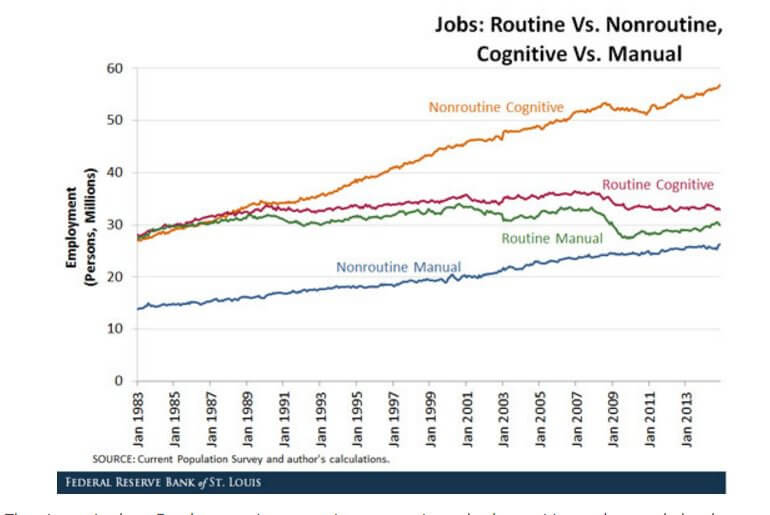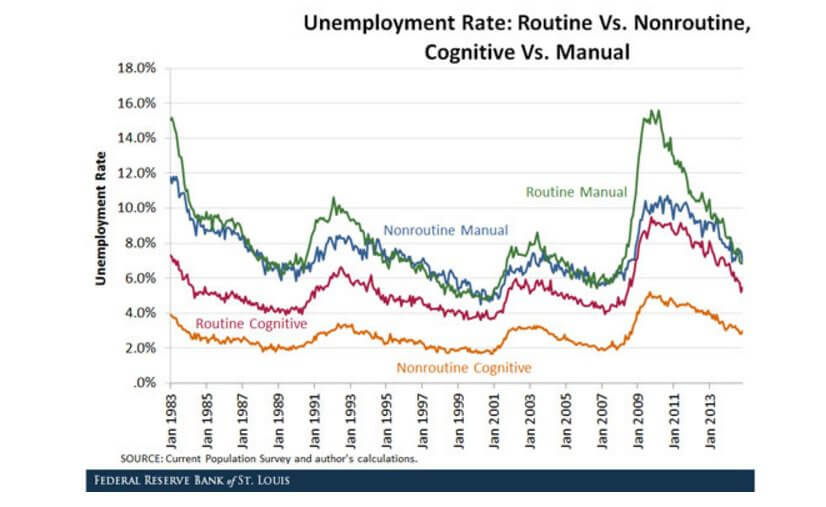Ricochet is the best place on the internet to discuss the issues of the day, either through commenting on posts or writing your own for our active and dynamic community in a fully moderated environment. In addition, the Ricochet Audio Network offers over 50 original podcasts with new episodes released every day.
 Two Charts: Job Automation in Action
Two Charts: Job Automation in Action
“Job polarization” is a wonky term that simply means the US labor market is seeing a decline of middle-skill occupations and growth in high- and low-skill occupations. Jobs are moving toward the extremes of worker skill levels.
Both automation and offshoring seem to be the driving factors. Particularly at risk are jobs that mostly require routine or repetitive tasks. A new St. Louis Fed analysis breaks it down this way: “a) nonroutine cognitive occupations, which include management and professional occupations; b) nonroutine manual occupations, which include service occupations related to assisting or caring for others; c) routine cognitive, which include sales and office occupations; and d) routine manual, which include construction, transportation, production and repair occupations.”
These two charts show employment and the jobless rates in each of the four job categories:


Summary:
Published in EconomicsEmployment in nonroutine occupations—both cognitive and manual—has been increasing steadily for several decades. Employment in routine occupations, however, has been mostly stagnant. … Occupations requiring a higher degree of cognitive skills had, on average, a lower unemployment rate. Also, routine manual jobs had a larger volatility in the unemployment rate, and nonroutine cognitive jobs had a smaller volatility. Nonroutine manual and routine cognitive jobs, on the other hand, had similar volatilities in the unemployment rate and, towards the end of the sample, similar levels.




If that top graph was measured as a percentage I’d be inclined to worry a lot more, but it’s not. It’s a measure of the number of people employed in those jobs, and look at the HUGE number people employed in nonroutine cognitive jobs!
Meanwhile, the nonroutine jobs aren’t disappearing, but are instead merely remaining flat.
This is a good news story.
That was my conclution as well. It’s not like people who can’t do cognitive jobs are losing opportunities for work. I read it as we’re moving from routine repetitive (some might say boring) jobs, to more dynamic jobs. That seems obvious as it’s much easier to build robots to do repetitive work which allows humans to change the type of productivity they’re doing on a moment’s notice and at their own discretion.
Lets think about this for a second. Its an unmitigated good news story only if the supply of potential employees who are only qualified for repetitive-task employment remains flat or declines. How does this square with increasing unskilled immigration, and declining SAT scores? Are we generating a group of unskilled/low skilled people for whom there is nothing to do?
The nonroutine manual tasks go to the low-skilled American workers who, nonetheless, at least speak English, leaving the flatlined repetitive tasks to the immigrants?
Meanwhile, I’m far more likely to blame unionization and regulation for the flatline in repetitive tasks than I am to blame automation.
This!
Sorry, but I guess we are defining ‘non-routine manual’ differently.
To me, plumber, electrician, mason, carpenter, mechanic etc are all ‘non-routine manual’ jobs, but definitely NOT low skill.
Textile industry is an example of once in decline in the U.S. to one that is slowly recovering. Went from 2.5 M jobs in the 1970’s down to 200K in the 90’s. Now with automation its back up to 400K jobs but requiring higher skilled better paid workers…no more Norma Rae’s. Problem is nothing is 100% American made only about 80% in any factory is U.S. made. Looms and chemicals are foreign. New materials and fabrics are making better products and owners say American labor versus foreign labor with shipping and tariffs makes American labor cheaper plus is higher quality.
The graphs only start in the 1980’s, when much routine mechanical work was already phased out.
Don’t see many ditch diggers these days, do you?
Which brings up another point, why are we distinguishing between routine and nonroutine? Anything that doesn’t require at least a low level of decision making has been phased over to robots already. With the possible exception of sales.